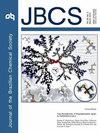月桂酸锰作为十一烷-2-酮吸附基质的研究:影响吸附的因素及其在信息素控释中的应用
IF 1.3
4区 化学
Q3 CHEMISTRY, MULTIDISCIPLINARY
引用次数: 0
摘要
农业面临的最大挑战之一是农用化学品的使用以及与过度使用这些物质有关的粮食生产和环境问题之间的平衡。为了解决这个问题,信息素被用来诱捕危害作物的害虫。本文报道了一种层状的单羧酸盐月桂酸锰(MnL2)作为吸附十一烷-2-一(甲基壬基酮(MNK))的基质,十一烷-2-一(甲基壬基酮(MNK))是草莓品种的害虫Lobiopa insularis的信息素成分之一。采用共沉淀法合成月桂酸锰,并用x射线衍射、振动光谱、热重分析和差示扫描量热法对其进行了表征。表征技术表明,MNK在月桂酸锰结构中的吸附范围为0.08 ~ 1.13 mg g-1,并通过因子设计实验考察了温度、接触时间和基质:MNK比等变量的相互作用。观察到温度升高的负面影响,并将其归因于底物挥发。随着摩尔比的增加和接触次数的增加,月桂酸锰的吸附效果较好,表明其可用于控释试验。本文章由计算机程序翻译,如有差异,请以英文原文为准。
Study of Manganese Laurate as Adsorbing Matrix for Undecan-2-one: Factors Affecting Adsorption for Application in Controlled-Release of Pheromones
One of the greatest challenges faced by agriculture is the use of agrochemicals and the balance between food production and environmental problems associated with the excessive use of these substances. To overcome this issue, pheromones have been used to trap pests that harm crops. This work reports the use of a layered monocarboxylate, manganese laurate (MnL2), as adsorbing matrix for undecan-2-one (methyl nonyl ketone (MNK)), one of the components of the pheromone of the insect Lobiopa insularis, which is a pest in the strawberry cultivar. The manganese laurate was synthesized by a coprecipitation method and was later characterized using X-ray diffractometry, vibrational spectroscopy, thermogravimetric analysis, and differential scanning calorimetry. The characterization techniques showed that MNK was adsorbed in the manganese laurate structure in a range of 0.08 to 1.13 mg g-1, and this interaction was investigated in a factorial design experiment, in which the variables temperature, time of contact, and matrix:MNK ratio were investigated. A negative effect of increasing temperatures was observed and attributed to substrate volatilization. The adsorption was favored in increasing molar ratios and times of contact, and ideal conditions for the adsorption could be found, indicating that manganese laurate could be applied in controlledrelease tests.
求助全文
通过发布文献求助,成功后即可免费获取论文全文。
去求助
来源期刊
CiteScore
2.90
自引率
7.10%
发文量
99
审稿时长
3.4 months
期刊介绍:
The Journal of the Brazilian Chemical Society embraces all aspects of chemistry except education, philosophy and history of chemistry. It is a medium for reporting selected original and significant contributions to new chemical knowledge.

 求助内容:
求助内容: 应助结果提醒方式:
应助结果提醒方式:


